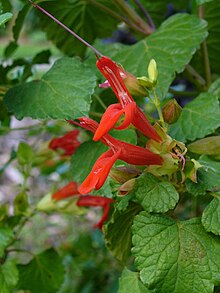
The Chisos Mountains, also known as the Chisos, are a mountain range located in the Big Bend area of the Trans-Pecos region of Texas, United States. The mountain system covers 40 square miles and is contained entirely within the boundaries of Big Bend National Park, making it the only mountain range in the United States fully contained within a national park. The Chisos Mountains are the southernmost mountain range in the mainland United States.
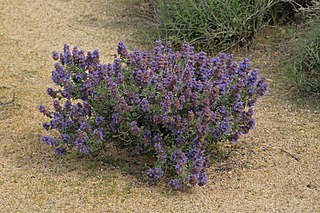
Salvia dorrii, the purple sage, Dorr's sage, fleshy sage, mint sage, or tobacco sage, is a perennial spreading shrub in the family Lamiaceae. It is native to mountain areas in the western United States and northwestern Arizona, found mainly in the Great Basin and southward to the Mojave Desert, growing in dry, well draining soils.

Salvia microphylla, the baby sage, Graham's sage, or blackcurrant sage, is an evergreen shrub found in the wild in southeastern Arizona and the mountains of eastern, western, and southern Mexico. It is a very complex species which easily hybridizes, resulting in numerous hybrids and cultivars brought into horticulture since the 1990s. The specific epithet microphylla, from the Greek, means "small leaved". In Mexico it is called mirto de montes, or "myrtle of the mountains".

Salvia buchananii, or Buchanan's sage, is a species of flowering plant in the mint family Lamiaceae. It is a herbaceous perennial or subshrub that was only found in the wild in the northeastern extreme of the state of Querétaro, Mexico, after fifty years of cultivation as a garden plant.

Salvia karwinskii is a perennial shrub native to the moist mountain forests of Mexico, Guatemala, Honduras, El Salvador, and Nicaragua, typically growing in or near pine or oak forests at 4,000 to 8,000 feet elevation. It is known as a honey-producing plant in those areas, but is rarely seen in private gardens. Specimens are grown at Strybing Arboretum, Huntington Botanical Gardens, and University of California Botanical Garden.
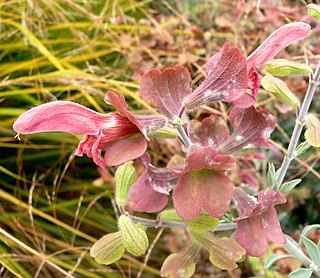
Salvia lanceolata is a perennial shrub native to a small area of coast on the Cape of Good Hope in South Africa. It is typically found growing in sandy ground at sea level, and on dry hills and flat ground up to 1000 feet elevation. Jean-Baptiste Lamarck, a pioneer in evolutionary theory, first described and named the plant "lanceolata" in 1791. Swedish botanist Carl Peter Thunberg, who was delayed in South Africa on the way to Japan, first collected it nearly twenty years earlier, along with approximately 3,000 plants that he later described. It wasn't until 1800 that Thunberg gave the plant the specific epithet "nivea", meaning 'snowy' in Latin, referring to the color of the foliage. Because of the rules of nomenclature, Lamarck's name had precedence because he was the first to name it.

Salvia longispicata is a perennial shrub native to southwestern Mexico, growing between 1,000 and 6,500 feet elevation. The specific epithet "longispicata" gives the impression that the plant has "long spikes", but instead refers to the many projecting clusters of short flowering spikes that resemble small ears of corn.
Salvia lycioides is a perennial native to a wide area ranging from west Texas and New Mexico in the U.S., south through Mexico to the state of San Luis Potosi. It typically grows on dry limestone hills and canyons above 5,000 feet elevation. It was named in 1886 by Asa Gray, the most respected American botanist of the 19th century. The specific epithet, "lycioides", from the Greek, is due to the plant's resemblance to Lycium, a genus also known as "boxthorn" in the nightshade family.
Salvia merjamie is a herbaceous perennial plant that is native to the east African highlands from Ethiopia to Tanzania, and also across the Red Sea in Yemen. It grows between 6,000 and 13,000 feet elevation in grasslands, forest edges, rocky outcrops, basalt slopes, and fallow fields. The specific epithet merjamie is derived from meryamiye, the Arabian common name for the plant, which is shared with other local Salvia species such as Salvia lanigera. The Maasai common name for S. merjamie is Naingungundeu, meaning that the plant smells of rats, though the variety that is common in horticulture is named 'Mint Sauce' and is described as having a strong minty aroma. S. merjamie shares a similar distribution with Salvia nilotica, though they are not known to hybridize.
Salvia moorcroftiana is a herbaceous perennial native to the Himalayan mountains from Pakistan to western Nepal, and is especially common in the Kashmir Valley. It grows between 5,000 and 9,000 feet elevation on disturbed areas and open slopes. The leaves are used medicinally in Kashmir.
Salvia namaensis is an evergreen perennial shrub native to a limited area in Namibia and a wide area of South Africa. It is typically found growing on rocky slopes, shales, limestone hills, and sandy soils at 1,000 to 5,000 feet elevation. The specific epithet namaensis probably refers to the Nama tribe which is indigenous to Namaqualand, the region in Namibia where the plant grows.
Salvia pentstemonoides is a herbaceous perennial that is rare in nature and native to only a few locations in Texas, including the Edwards Plateau. The plant remains endangered due to destruction of habitat and browsing by deer. The severe Texas drought of the 1950s may have contributed to its decline.
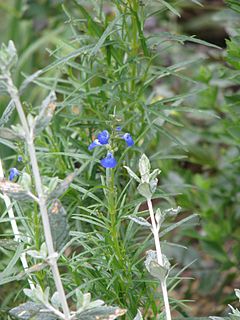
Salvia reptans is a widely distributed herbaceous perennial native to the mountains of the Trans-Pecos in Texas, and in Mexico and Guatemala. It typically grows in dry stream beds and gravelly soils. It was introduced into horticulture in the 19th century and was previously known as S. angustifolia and S. leptophylla, both of which refer to the slender leaves. The specific epithet reptans refers to the plant's creeping habit.
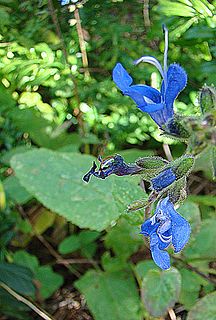
Salvia scutellarioides is an evergreen perennial native to the Andes Mountains in Ecuador, Colombia, and Peru, growing at elevations from 3,300 to 10,000 feet in mild climates where there is year-round moisture. Even though it was described by Carl Sigismund Kunth in 1817, as of 2002 it was still rarely seen in horticulture. The specific epithet is due to its similarity to Scutellaria, a genus in the mint family.

Salvia sessei is a perennial that grows in several states in central Mexico between 600 and 7,000 feet elevation on the edge of pine forests and woodlands. It was first collected by the Spanish botanist Martín Sessé y Lacasta and the Mexican-born Spanish naturalist José Mariano Mociño. The two were part of the Royal Botanical Expedition of 1777 sent by King Charles III of Spain to Guatemala and Mexico.
Salvia staminea is a herbaceous perennial shrub native to a wide area in Asia Minor that includes Turkey, Georgia, Armenia, and Iran, where it grows at elevations from 6,000 feet (1,800 m) to 14,000 feet (4,300 m). It is typically found growing in alpine meadows, screes, and cliffs, sometimes growing with scrub oak. Due to the wide variety of habitats in which it is found, there is a wide degree of variation in the species. It was first described in 1836 and has only slowly come into use in horticulture.
Salvia stenophylla is a perennial shrub native to a wide area of Southern Africa: South Africa, Botswana and Namibia. It grows on grassy or stony slopes, and in open countryside or among shrubs. It has been used traditionally as a disinfectant by burning it in huts after sickness, and it is also mixed with tobacco for smoking. Its specific epithet, stenophylla, refers to the narrow leaves.

Salvia thymoides is an evergreen perennial shrub native to a small region in Mexico on the border of Oaxaca and Puebla states, growing at elevations from 7,000 feet (2,100 m) to 9,000 feet (2,700 m). Its native habitat is cloud forest, with the mountains catching regular moisture in the form of fog and rain. The plant was named by the botanist George Bentham in 1833, with the specific epithet, thymoides, referring to the small leaves which resemble those of thyme. It has a limited use in horticulture, introduced in the 1980s.
Salvia villosa is a herbaceous perennial that is native to the Mexican states of San Luis Potosi and Coahuila, growing at approximately 4,000 feet (1,200 m) elevation in dry areas that have little or no frost.

Salvia viscosa is a herbaceous perennial native to a small area of mountains in Lebanon and Israel. It was first described in 1781 by Nikolaus Joseph von Jacquin but only began being sold in nurseries in the 1990s.
